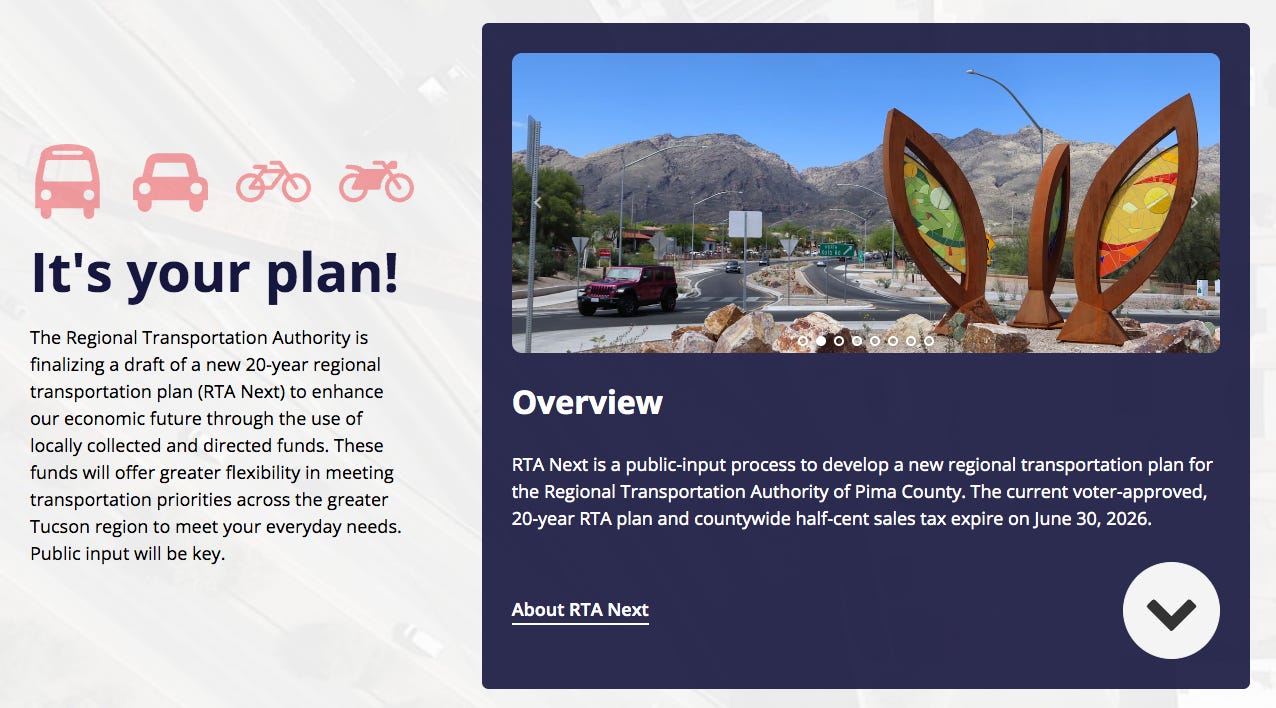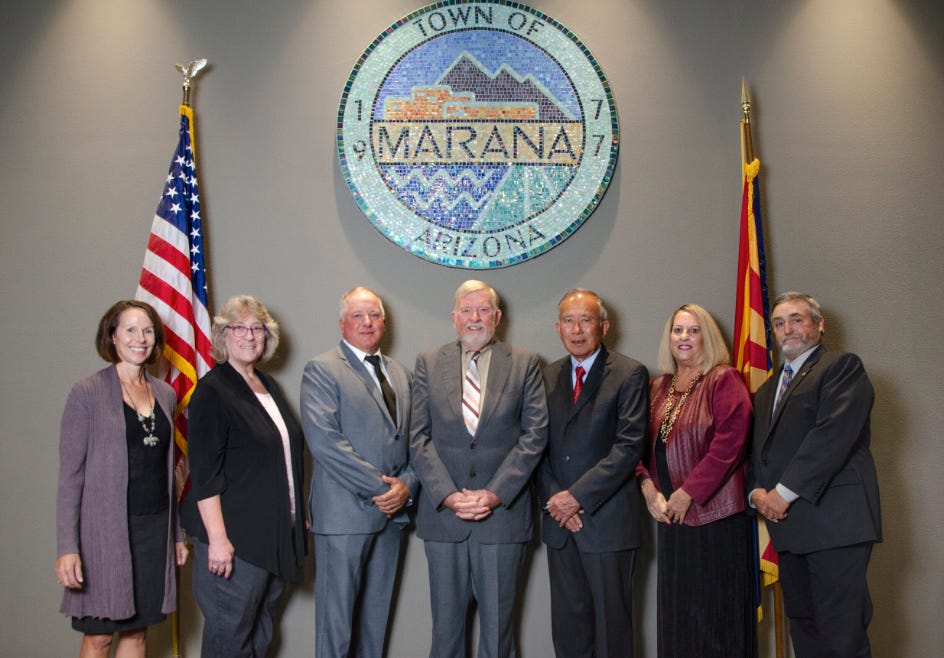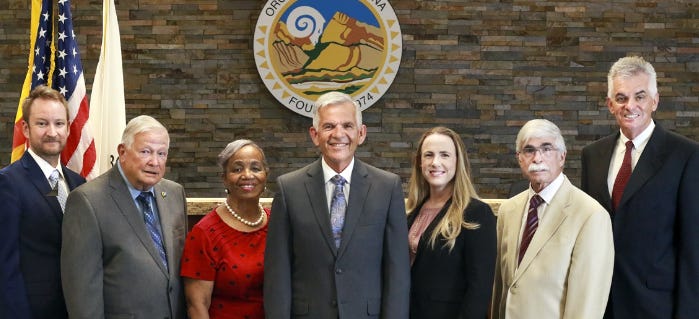The Daily Agenda: Transit is the talk of the town(s)
We hear a lot from the big guys ... But the smaller towns get drowned out ... McLean says he'll run against Wadsack.
The transportation plan known as RTA Next has been the talk of Tucson in recent months, but what do smaller towns across the county have to say about it?
Their voices sometimes get drowned out by officials in larger jurisdictions like the City of Tucson and Pima County. But when we checked on recent public meetings in Marana, Oro Valley, and South Tucson we found that just because you don’t often hear from them doesn’t mean they’re not expressing their opinions, often colorfully, about what they want from RTA Next.
Before we get to that, it’s worth taking a moment to explain the basics of RTA Next and why officials are talking about it.
Local officials are facing the end of a sales tax in 2026 that generates a ton of money for transportation projects. Eight local government bodies have been doing it as a region, rather than individually, under the auspices of the Regional Transportation Authority for nearly 20 years.
There’s a tentative consensus to keep that regional attitude, but there’s also a lot of money at stake, at least $2 billion over 20 years, and everybody has a long list of projects that need attention.
The plan is to ask voters to approve a new sales tax before the old one ends. Officials have been hammering out their top priorities and negotiating how much money each jurisdiction will get under what they call RTA Next.
They’ve also been dealing with the politics of it all. The loudest voices are coming from the City of Tucson, by far the biggest player in the RTA, who worry the city will be shortchanged by hundreds of millions of dollars over the next two decades.
In an ominous sign for RTA Next, the Tucson City Council earlier this month set an election for a half-cent sales tax election in July. Although they haven’t explained exactly how the money would be spent, one of the possibilities would be to give Tucson a path to “going it alone and not participating in RTA Next,” Councilman Steve Kozachik said Feb. 7 on the Buckmaster Show.
Marana Town Council: “Stab in the back”
The Marana Town Council emphasized the “regional” component of the RTA acronym at their Feb. 6 council meeting. They generally support RTA Next, but at the same time they don’t want to sacrifice the needs of town residents on behalf of Tucsonans.
Public transportation was one sticking point that came up at the meeting. The town’s residents rely far less on it than Tucsonans, so Marana officials said they didn’t want to pay for public transit infrastructure that doesn’t benefit their residents.
The political jousting of the RTA Next negotiations also grated on at least one of the council members.
Council member Roxanne Ziegler said Marana needs RTA Next, but she didn’t want the town to have to deal with “threats” from Tucson officials saying they might pull out of the deal. Instead, she said if Tucson wants to pull out, she would “show them the door.”
Ziegler called the move by the Tucson City Council to hold a sales tax election a “stab in the back.”
“We can’t play their games anymore, that’s ridiculous, and (Tucson Mayor) Regina Romero should be ashamed of herself to even think that they were going to do this. Let them pass their sales tax, or let them put it on the ballot, and I hope the people of Tucson vote ‘no,’ and then we don’t let them back in,” Ziegler said.
Mayor Ed Honea said he and other officials have put in long hours on negotiations and he hoped a deal would be reached. But he was concerned about Marana not getting its fair share.
“I’ll be real honest with you, I don't know if we’re gonna make it, but we’re trying. If we can come to an agreement, it will benefit the entire county. So we’re hoping we can, but we’re not going to sell out the people of Marana to make it happen,” Honea said.
Oro Valley: Keep it regional or be “selfish”?
Like officials in Marana, the Oro Valley Town Council wants to keep the regional element of the RTA. But the council members don’t completely agree about how much Oro Valley should sacrifice, or how essential the RTA actually is to the town.
RTA funding helps the town improve corridors, establish wildlife protections and make intersections safer. But even if the town had to go without the RTA, it’s “not all doom and gloom for Oro Valley,” Council Member Josh Nicolson said at their Feb. 16 meeting. They could still partner with one or a few local jurisdictions separately from the RTA or come up with other sources of funding.
Nicolson noted the importance of Tucson to the surrounding towns, saying “we all benefit when Tucson’s roads and infrastructure are better.”
Unlike Nicolson, Council Member Timothy Bohen said Oro Valley should focus on the town’s projects before even considering projects for other jurisdictions.
“I know it sounds selfish, but we’re supposed to be selfish. We represent our residents and what they pay for, and I think the money that we put in should come to things that are really needed in the town,” Bohen said.
Council Member Steve Solomon seemed concerned that Oro Valley, or any of the other RTA members, would end up acting too selfishly.
“The whole point of the RTA is regional transportation, not City of Tucson ‘what do I get,’ Pima County ‘what do I get,’ Marana ‘what do I get.’ If we devolve into that, then there’s no region,” Solomon said.
South Tucson: “Do they serve the urban places?”
Unlike Marana or Oro Valley, public transportation is one of the main issues at the South Tucson City Council when it comes to RTA Next.
As a more urban area, the city needs more investment in public transportation than Marana or Oro Valley. In fact, the bus routes in South Tucson are some of the heaviest used routes in the Tucson metro area, Council Member Cesar Aguirre said at their Jan. 16 meeting.
South Tucson council members also echoed the Tucson City Council’s concern about the RTA not serving the needs of inner-city areas. Some South Tucson council members suggested they should ditch the RTA altogether and find another way to fund the projects that will benefit residents of South Tucson.
Council member Brian Flagg said the city should be more aligned with Tucson, which is also an urban area, and consider dropping out of RTA Next.
“Maybe we should just be ‘no’ on RTA Next because the RTA soaks everybody for a half cent, and then, do they serve the inner cities? Do they serve the urban places, or do they serve the perimeter of Tucson and like, put in a bunch of fancy stuff for the perimeter that doesn’t help us?” Flagg said.
Throwing his hat in the ring: Republican state Sen. Justine Wadsack could be facing a challenger in the state Senate race in LD17, after Democrat John McLean filed a statement of interest earlier this month, the Tucson Sentinel’s Jim Nintzel writes. McLean, an executive with a long career working for a high-tech defense contractor, has been active for years in Tucson’s dog rescue community. He previously served as CEO of Areté Associates and also worked for TRW Space and Defense group.
No pause in this plan: Construction plans for the University of Arizona veterinary school’s $49 million new facility are moving forward, despite the university’s freeze on capital projects, the Arizona Daily Star’s Jessica Votipka writes. The school is pausing several capital projects through the end of June while it deals with a $177 million deficit, including a $30 million College of Veterinary Medicine Surgical Center and $15 million Human Animal Interaction Building. The dean of the veterinary school said fundraising efforts will continue during the delay and the plan has always been to wait to build the new facilities until funding has been secured.
Speaking of the UA: The UA has delayed implementation of its climate action plan, citing the budget deficit, Grist’s Anita Hofschneider writes. A UA spokesman said administrators are “reassessing how to approach the final steps in the development” of its Sustainability and Climate Action Plan to make sure it best supports the school’s Financial Action Plan. Six working groups and two technical teams spent last fall drafting nearly 100 recommendations to decrease carbon emissions at the UA, including divesting from fossil fuels by 2030.
Gun lawsuit in flux: A federal judge in Tucson is considering whether a lawsuit filed by the Mexican government against five Arizona gun dealers will move forward, the Sentinel's Paul Ingram reports. U.S District Court Judge Rosemary Marquez heard arguments last week, but did not rule on a motion to dismiss the case, telling lawyers she’d take the matter under advisement. The Mexican government has filed two separate suits against the U.S. for its inability to limit gun smuggling, saying that gun dealers Diamondback Shooting Sports, SnG Tactical, Ammo AZ, Sprague's Sports, and The Hub “systematically participate in trafficking military-style weapons and ammunition to drug cartels in Mexico by supplying gun traffickers.”
Big bucks in state trust lands: A team of Grist reporters examined how 14 universities, including the UA, are profiting from land stolen from Indigenous people that has been used to produce revenue for the colleges through logging, drilling and mining. The UA retains the rights to nearly 687,000 acres of land and has rights to another 703,000 subsurface acres, a term related to oil, gas, minerals and other underground resources. In 2022, the UA’s state trust lands provided the institution $7.7 million, which is enough money to have paid the full cost of attendance for more than half of every Native undergraduate at the Tucson campus that year.
Celebrating history: The Star’s Cathalena E. Buch and Jamie Donnelly take readers on a tour of South Tucson’s historic dining scene, talking with next gen restaurateurs and chefs who are running their families' historic restaurants. There are seven long standing restaurants along the South Fourth Avenue corridor, and several others along South Sixth Avenue.
“I think when people think of South Tucson they think of the long-lasting restaurants," said Interim South Tucson City Manager Veronica Moreno, a City of South Tucson native who also works as city clerk and human resources director. "It describes our culture and it gives us identity. You have restaurants that go back to the 1950s.”
The following letter is in response to Friday’s Tucson Agenda, “Lawmaking is hard.”
It’s about more than bills
I reject your article’s suggestion that a lawmaker’s worth is in introducing bills that get passed. A legislator’s work shapes and amends existing bills, approves good ones, rejects bad ones, sets budget priorities, monitors the execution of current law and affirms people for government offices. Most importantly, legislators give voice to the values of their constituents. I would rather have elected officials who fight the good fight on my behalf than to have officials who feel their job is to appease colleagues to get their bills passed at any cost.
Elena Acoba, resident of Casas Adobes
48,000: The population of Oro Valley. Marana is home to 56,000 and South Tucson is home to 4,600.











